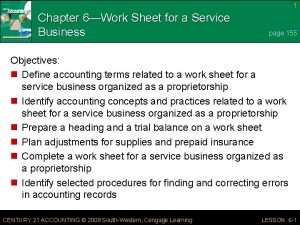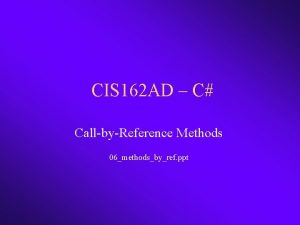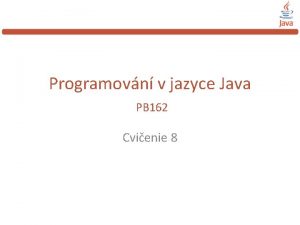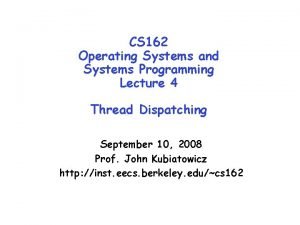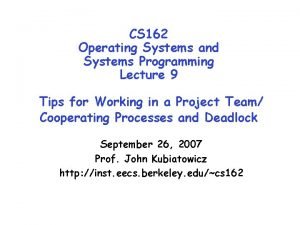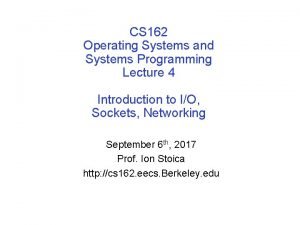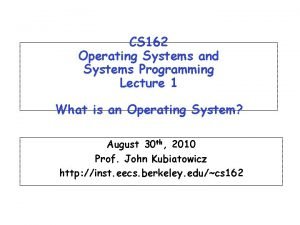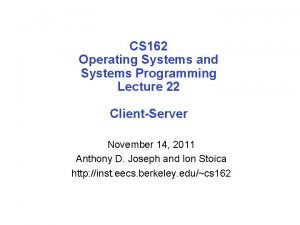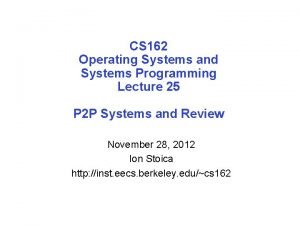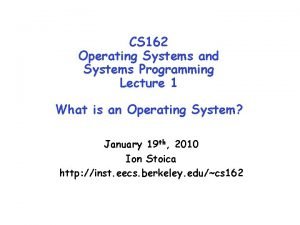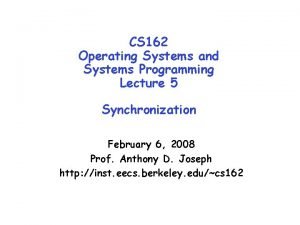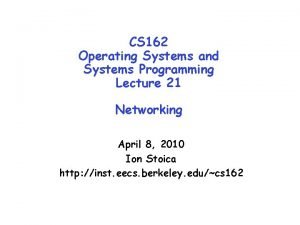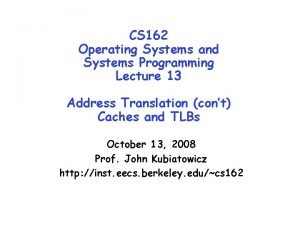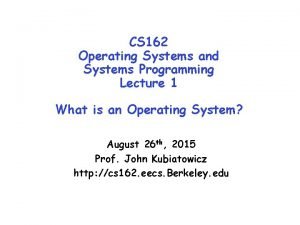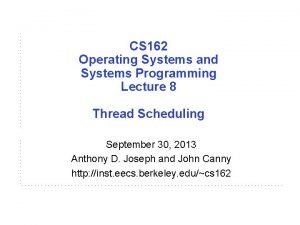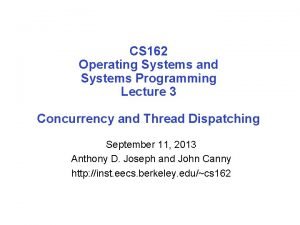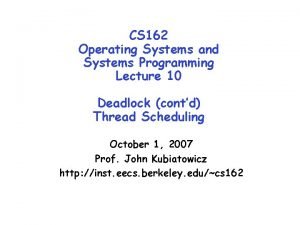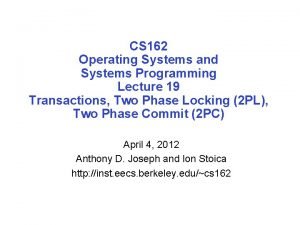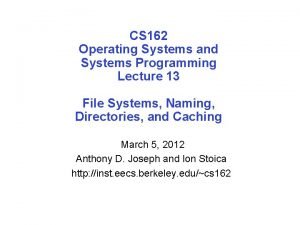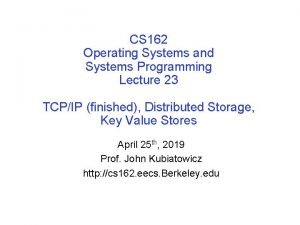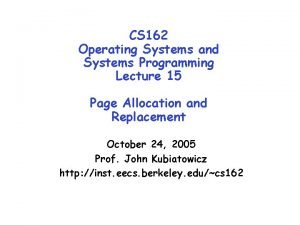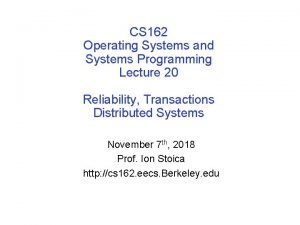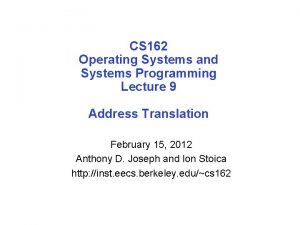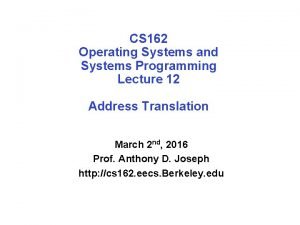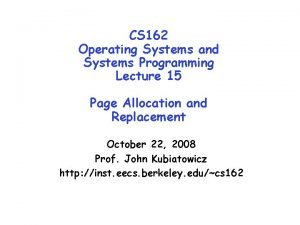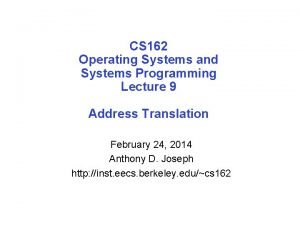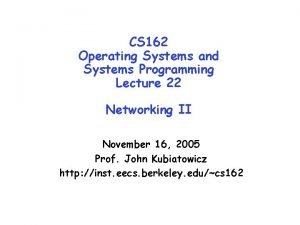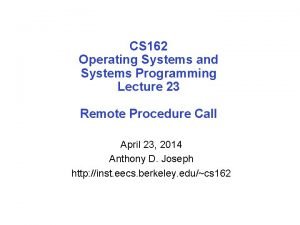CS 162 Operating Systems and Systems Programming Lecture






























- Slides: 30

CS 162 Operating Systems and Systems Programming Lecture 5 Cooperating Threads September 14, 2009 Prof. John Kubiatowicz http: //inst. eecs. berkeley. edu/~cs 162

Review: Per Thread State • Each Thread has a Thread Control Block (TCB) – Execution State: CPU registers, program counter, pointer to stack – Scheduling info: State (more later), priority, CPU time – Accounting Info – Various Pointers (for implementing scheduling queues) – Pointer to enclosing process? (PCB)? – Etc (add stuff as you find a need) • OS Keeps track of TCBs in protected memory – In Arrays, or Linked Lists, or … Head Tail Ready Queue 9/14/09 Link Registers Other State TCB 6 Kubiatowicz CS 162 ©UCB Fall 2009 Link Registers Other State TCB 16 Lec 5. 2

Review: Yielding through Internal Events • Blocking on I/O – The act of requesting I/O implicitly yields the CPU • Waiting on a “signal” from other thread – Thread asks to wait and thus yields the CPU • Thread executes a yield() – Thread volunteers to give up CPU compute. PI() { while(TRUE) { Compute. Next. Digit(); yield(); } } – Note that yield() must be called by programmer frequently enough! 9/14/09 Kubiatowicz CS 162 ©UCB Fall 2009 Lec 5. 3

Review: Stack for Yielding Thread Compute. PI kernel_yield run_new_thread switch Stack growth Trap to OS yield • How do we run a new thread? run_new_thread() { new. Thread = Pick. New. Thread(); switch(cur. Thread, new. Thread); Thread. House. Keeping(); /* Later in lecture */ } • How does dispatcher switch to a new thread? – Save anything next thread may trash: PC, regs, stack – Maintain isolation for each thread 9/14/09 Kubiatowicz CS 162 ©UCB Fall 2009 Lec 5. 4

Review: Two Thread Yield Example proc A() { B(); } proc B() { while(TRUE) { yield(); } } Stack growth • Consider the following code blocks: Thread S Thread T A A B(while) yield run_new_thread switch • Suppose we have 2 threads: – Threads S and T 9/14/09 Kubiatowicz CS 162 ©UCB Fall 2009 Lec 5. 5

Goals for Today • More on Interrupts • Thread Creation/Destruction • Cooperating Threads Note: Some slides and/or pictures in the following are adapted from slides © 2005 Silberschatz, Galvin, and Gagne Many slides generated from my lecture notes by Kubiatowicz. 9/14/09 Kubiatowicz CS 162 ©UCB Fall 2009 Lec 5. 6

Interrupt Controller Priority Encoder Interrupt Mask Timer Network Int. ID Interrupt Software Interrupt Control CPU Int Disable NMI • Interrupts invoked with interrupt lines from devices • Interrupt controller chooses interrupt request to honor – Mask enables/disables interrupts – Priority encoder picks highest enabled interrupt – Software Interrupt Set/Cleared by Software – Interrupt identity specified with ID line • CPU can disable all interrupts with internal flag • Non-maskable interrupt line (NMI) can’t be disabled 9/14/09 Kubiatowicz CS 162 ©UCB Fall 2009 Lec 5. 7

Example: Network Interrupt d nts Raise priority e v I de. Reenable All Ints a s o ll add $r 1, $r 2, $r 3 A M Save registers C P le r subi $r 4, $r 1, #4 Dispatch to Handler b iso a slli $r 4, #2 v s Di per Transfer Network Su Packet from hardware Pipeline Flush lw lw add sw Re $r 2, 0($r 4) s $r 3, 4($r 4) Use tor r e. P $r 2, $r 3 M od C 8($r 4), $r 2 e to Kernel Buffers Restore registers Clear current Int Disable All Ints Restore priority RTI “Interrupt Handler” External Interrupt • Disable/Enable All Ints Internal CPU disable bit – RTI reenables interrupts, returns to user mode • Raise/lower priority: change interrupt mask • Software interrupts can be provided entirely in software at priority switching boundaries 9/14/09 Kubiatowicz CS 162 ©UCB Fall 2009 Lec 5. 8

Review: Preemptive Multithreading • Use the timer interrupt to force scheduling decisions Interrupt Timer. Interrupt run_new_thread switch Stack growth Some Routine • Timer Interrupt routine: Timer. Interrupt() { Do. Periodic. House. Keeping(); run_new_thread(); } • This is often called preemptive multithreading, since threads are preempted for better scheduling – Solves problem of user who doesn’t insert yield(); 9/14/09 Kubiatowicz CS 162 ©UCB Fall 2009 Lec 5. 9

Administrivia • Need group in section 101 to add member – We have a student that is unattached • Information about Subversion on Handouts page – Make sure to take a look • Other things on Handouts page – Synchronization examples/Interesting papers – Previous finals/solutions • Sections in this class are mandatory – Make sure that you go to the section that you have been assigned! • Reader is available at Copy Central on Hearst • Should be reading Nachos code by now! – Get working on the first project – Set up regular meeting times with your group – Try figure out group interaction problems early on 9/14/09 Kubiatowicz CS 162 ©UCB Fall 2009 Lec 5. 10

Review: Lifecycle of a Thread (or Process) • As a thread executes, it changes state: – – – new: The thread is being created ready: The thread is waiting to running: Instructions are being executed waiting: Thread waiting for some event to occur terminated: The thread has finished execution • “Active” threads are represented by their TCBs – TCBs organized into queues based on their state 9/14/09 Kubiatowicz CS 162 ©UCB Fall 2009 Lec 5. 11

Thread. Fork(): Create a New Thread • Thread. Fork() is a user-level procedure that creates a new thread and places it on ready queue – We called this Create. Thread() earlier • Arguments to Thread. Fork() – Pointer to application routine (fcn. Ptr) – Pointer to array of arguments (fcn. Arg. Ptr) – Size of stack to allocate • Implementation – – 9/14/09 Sanity Check arguments Enter Kernel-mode and Sanity Check arguments again Allocate new Stack and TCB Initialize TCB and place on ready list (Runnable). Kubiatowicz CS 162 ©UCB Fall 2009 Lec 5. 12

How do we initialize TCB and Stack? • Initialize Register fields of TCB – Stack pointer made to point at stack – PC return address OS (asm) routine Thread. Root() – Two arg registers (a 0 and a 1) initialized to fcn. Ptr and fcn. Arg. Ptr, respectively • Initialize stack data? – No. Important part of stack frame is in registers (ra) – Think of stack frame as just before body of Thread. Root() really gets started Stack growth Thread. Root stub Initial Stack 9/14/09 Kubiatowicz CS 162 ©UCB Fall 2009 Lec 5. 13

How does Thread get started? Other Thread Stack growth Thread. Root A B(while) yield run_new_thread New Thread switch Thread. Root stub • Eventually, run_new_thread() will select this TCB and return into beginning of Thread. Root() – This really starts the new thread 9/14/09 Kubiatowicz CS 162 ©UCB Fall 2009 Lec 5. 14

What does Thread. Root() look like? • Thread. Root() is the root for the thread routine: Thread. Root() { Do. Startup. Housekeeping(); User. Mode. Switch(); /* enter user mode */ Call fcn. Ptr(fcn. Arg. Ptr); Thread. Finish(); } – Includes things like recording start time of thread – Other Statistics Thread. Root Thread Code Stack growth • Startup Housekeeping • Stack will grow and shrink Running Stack with execution of thread • Final return from thread returns into Thread. Root() which calls Thread. Finish() – Thread. Finish() will start at user-level 9/14/09 Kubiatowicz CS 162 ©UCB Fall 2009 Lec 5. 15

What does Thread. Finish() do? • Needs to re-enter kernel mode (system call) • “Wake up” (place on ready queue) threads waiting for this thread – Threads (like the parent) may be on a wait queue waiting for this thread to finish • Can’t deallocate thread yet – We are still running on its stack! – Instead, record thread as “waiting. To. Be. Destroyed” • Call run_new_thread() to run another thread: run_new_thread() { new. Thread = Pick. New. Thread(); switch(cur. Thread, new. Thread); Thread. House. Keeping(); } – Thread. House. Keeping() notices waiting. To. Be. Destroyed and deallocates the finished thread’s TCB and stack 9/14/09 Kubiatowicz CS 162 ©UCB Fall 2009 Lec 5. 16

Additional Detail • Thread Fork is not the same thing as UNIX fork – UNIX fork creates a new process so it has to create a new address space – For now, don’t worry about how to create and switch between address spaces • Thread fork is very much like an asynchronous procedure call – Runs procedure in separate thread – Calling thread doesn’t wait for finish • What if thread wants to exit early? – Thread. Finish() and exit() are essentially the same procedure entered at user level 9/14/09 Kubiatowicz CS 162 ©UCB Fall 2009 Lec 5. 17

Parent-Child relationship Typical process tree for Solaris system • Every thread (and/or Process) has a parentage – A “parent” is a thread that creates another thread – A child of a parent was created by that parent 9/14/09 Kubiatowicz CS 162 ©UCB Fall 2009 Lec 5. 18

Thread. Join() system call • One thread can wait for another to finish with the Thread. Join(tid) call – Calling thread will be taken off run queue and placed on waiting queue for thread tid • Where is a logical place to store this wait queue? – On queue inside the TCBtid Termination Wait queue Head Tail Link Registers Other State TCB 9 Link Registers Other State TCB 6 Link Registers Other State TCB 16 • Similar to wait() system call in UNIX – Lets parents wait for child processes 9/14/09 Kubiatowicz CS 162 ©UCB Fall 2009 Lec 5. 19

Use of Join for Traditional Procedure Call • A traditional procedure call is logically equivalent to doing a Thread. Fork followed by Thread. Join • Consider the following normal procedure call of B() by A(): A() { B(); } B() { Do interesting, complex stuff } • The procedure A() is equivalent to A’(): A’() { tid = Thread. Fork(B, null); Thread. Join(tid); } • Why not do this for every procedure? – Context Switch Overhead – Memory Overhead for Stacks 9/14/09 Kubiatowicz CS 162 ©UCB Fall 2009 Lec 5. 20

Kernel versus User-Mode threads • We have been talking about Kernel threads – Native threads supported directly by the kernel – Every thread can run or block independently – One process may have several threads waiting on different things • Downside of kernel threads: a bit expensive – Need to make a crossing into kernel mode to schedule • Even lighter weight option: User Threads – User program provides scheduler and thread package – May have several user threads per kernel thread – User threads may be scheduled non-premptively relative to each other (only switch on yield()) – Cheap • Downside of user threads: – When one thread blocks on I/O, all threads block – Kernel cannot adjust scheduling among all threads – Option: Scheduler Activations » Have kernel inform user level when thread blocks… 9/14/09 Kubiatowicz CS 162 ©UCB Fall 2009 Lec 5. 21

Threading models mentioned by book Simple One-to-One Threading Model Many-to-One 9/14/09 Many-to-Many Kubiatowicz CS 162 ©UCB Fall 2009 Lec 5. 22

Multiprocessing vs Multiprogramming • Remember Definitions: – Multiprocessing Multiple CPUs – Multiprogramming Multiple Jobs or Processes – Multithreading Multiple threads per Process • What does it mean to run two threads “concurrently”? – Scheduler is free to run threads in any order and interleaving: FIFO, Random, … – Dispatcher can choose to run each thread to completion or time-slice in big chunks or small chunks Multiprocessing A B C A Multiprogramming 9/14/09 A B B C A C B Kubiatowicz CS 162 ©UCB Fall 2009 C B Lec 5. 23

Correctness for systems with concurrent threads • If dispatcher can schedule threads in any way, programs must work under all circumstances – Can you test for this? – How can you know if your program works? • Independent Threads: – – No state shared with other threads Deterministic Input state determines results Reproducible Can recreate Starting Conditions, I/O Scheduling order doesn’t matter (if switch() works!!!) • Cooperating Threads: – Shared State between multiple threads – Non-deterministic – Non-reproducible • Non-deterministic and Non-reproducible means that bugs can be intermittent – Sometimes called “Heisenbugs” 9/14/09 Kubiatowicz CS 162 ©UCB Fall 2009 Lec 5. 24

Interactions Complicate Debugging • Is any program truly independent? – Every process shares the file system, OS resources, network, etc – Extreme example: buggy device driver causes thread A to crash “independent thread” B • You probably don’t realize how much you depend on reproducibility: – Example: Evil C compiler » Modifies files behind your back by inserting errors into C program unless you insert debugging code – Example: Debugging statements can overrun stack • Non-deterministic errors are really difficult to find – Example: Memory layout of kernel+user programs » depends on scheduling, which depends on timer/other things » Original UNIX had a bunch of non-deterministic errors – Example: Something which does interesting I/O 9/14/09 » User typing of letters used to help generate secure keys Kubiatowicz CS 162 ©UCB Fall 2009 Lec 5. 25

Why allow cooperating threads? • People cooperate; computers help/enhance people’s lives, so computers must cooperate – By analogy, the non-reproducibility/non-determinism of people is a notable problem for “carefully laid plans” • Advantage 1: Share resources – One computer, many users – One bank balance, many ATMs » What if ATMs were only updated at night? – Embedded systems (robot control: coordinate arm & hand) • Advantage 2: Speedup – Overlap I/O and computation » Many different file systems do read-ahead – Multiprocessors – chop up program into parallel pieces • Advantage 3: Modularity – More important than you might think – Chop large problem up into simpler pieces 9/14/09 » To compile, for instance, gcc calls cpp | cc 1 | cc 2 | as | ld » Makes system easier to extend Kubiatowicz CS 162 ©UCB Fall 2009 Lec 5. 26

High-level Example: Web Server • Server must handle many requests • Non-cooperating version: server. Loop() { con = Accept. Con(); Process. Fork(Service. Web. Page(), con); } • What are some disadvantages of this technique? 9/14/09 Kubiatowicz CS 162 ©UCB Fall 2009 Lec 5. 27

Threaded Web Server • Now, use a single process • Multithreaded (cooperating) version: server. Loop() { connection = Accept. Con(); Thread. Fork(Service. Web. Page(), connection); } • Looks almost the same, but has many advantages: – Can share file caches kept in memory, results of CGI scripts, other things – Threads are much cheaper to create than processes, so this has a lower per-request overhead • Question: would a user-level (say one-to-many) thread package make sense here? – When one request blocks on disk, all block… • What about Denial of Service attacks or digg / Slash -dot effects? 9/14/09 Kubiatowicz CS 162 ©UCB Fall 2009 Lec 5. 28

Thread Pools • Problem with previous version: Unbounded Threads – When web-site becomes too popular – throughput sinks • Instead, allocate a bounded “pool” of worker threads, representing the maximum level of multiprogramming queue Master Thread Pool master() { alloc. Threads(worker, queue); while(TRUE) { con=Accept. Con(); Enqueue(queue, con); wake. Up(queue); } } 9/14/09 Kubiatowicz CS 162 worker(queue) { while(TRUE) { con=Dequeue(queue); if (con==null) sleep. On(queue); else Service. Web. Page(con); } } ©UCB Fall 2009 Lec 5. 29

Summary • Interrupts: hardware mechanism for returning control to operating system – Used for important/high-priority events – Can force dispatcher to schedule a different thread (premptive multithreading) • New Threads Created with Thread. Fork() – Create initial TCB and stack to point at Thread. Root() – Thread. Root() calls thread code, then Thread. Finish() – Thread. Finish() wakes up waiting threads then prepares TCB/stack for distruction • Threads can wait for other threads using Thread. Join() • Threads may be at user-level or kernel level • Cooperating threads have many potential advantages – But: introduces non-reproducibility and non-determinism – Need to have Atomic operations 9/14/09 Kubiatowicz CS 162 ©UCB Fall 2009 Lec 5. 30
 Operating system lecture notes
Operating system lecture notes 01:640:244 lecture notes - lecture 15: plat, idah, farad
01:640:244 lecture notes - lecture 15: plat, idah, farad C data types with examples
C data types with examples Prime factorization of 84 using exponents
Prime factorization of 84 using exponents A man rode on his motorcycle for 162 miles
A man rode on his motorcycle for 162 miles Tutti i numeri composti
Tutti i numeri composti Lcm of 90 and 30
Lcm of 90 and 30 M.c.d de 126 y 162
M.c.d de 126 y 162 Apsc 162
Apsc 162 Prime factorization of 24
Prime factorization of 24 Komulator
Komulator Simplify the ratios 18 is 72 is 162
Simplify the ratios 18 is 72 is 162 6-1 work together p. 162 answers
6-1 work together p. 162 answers 6-1 work together p. 162 answers
6-1 work together p. 162 answers What is written on the three-line heading on a worksheet?
What is written on the three-line heading on a worksheet? 7 sınıf en'âm suresi 162. ayet
7 sınıf en'âm suresi 162. ayet Rle 162
Rle 162 6-1 work together p. 162
6-1 work together p. 162 6 18 54 162
6 18 54 162 162 ad
162 ad Pb 162
Pb 162 Cs 162
Cs 162 Cs 162
Cs 162 Cs 162
Cs 162 Cs 162
Cs 162 Abcdefghijklmnopqrstvwxyz
Abcdefghijklmnopqrstvwxyz Perbedaan linear programming dan integer programming
Perbedaan linear programming dan integer programming Greedy algorithm vs dynamic programming
Greedy algorithm vs dynamic programming What is system programming
What is system programming Integer programming vs linear programming
Integer programming vs linear programming Definisi linear
Definisi linear

















